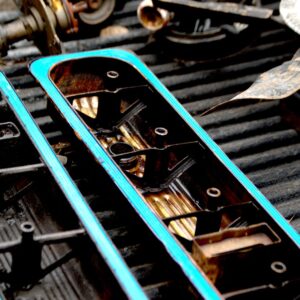If you’re a real “Fast & Furious” fan, then you’ve no doubt heard of the legendary 1994 Toyota Supra MK IV. Driven by fan favorite Brian O’Conner, the Supra is a dream car for many. With a sleek orange paint job and blue suede and black leather upholstery, its appearance all but screams star quality.
But its stylish appearance isn’t the only reason behind its popularity. Today, many fans continue to pine for the Supra because of its powerful 2JZ engine.
What Is a 2JZ Engine?
Manufactured by Toyota, the 2JZ is a powerful engine with an inline-six cylinder unit. It has two inline-three cylinder engines fused together, creating two opposing forces that cancel each other out. Because of this, 2JZ engines can withstand higher revolutions per minute (RPM) without falling apart.

There are three variations of the 2JZ engine, namely the following:
2JZ-GE Engine
Before the famous 2JZ-GTE hit the market, there was its predecessor: the 2JZ-GE. The 2JZ-GE is a naturally aspirated engine with a dual overhead cam setup and an electrically fueled injection.
With a 10:1 compression ratio and a dual-stage manifold, the 2JZ-GE can reach around 210 to 230 horsepower. It isn’t as powerful as the GTE variation, but its cast-iron cylinder block and aluminum head make it just as durable as its successor.
Some examples of vehicles with the GE engine include the Toyota Altezza, Toyota Aristo, Toyota Crown, Lexus GS300, and Lexus IS300.
2JZ-GTE Engine
As Toyota’s performance flagship engine, it’s no surprise that the GTE is the most popular of the 2JZ engines. It has the same dual overhead camshaft as the GE but with upgraded inlet and exhaust ports, cams, and valves, and a new twin-turbo forced induction system.
The GTE engine offers a low compression ratio of 8.5:1 and can easily reach the industry maximum of 276 horsepower. However, outside of Japan, the 2JZ-GTE can go up to 320 horsepower.
Some popular Toyota models with the GTE engine include the Supra RZ, Supra Turbo, and Aristo 3.0V.
2JZ-FSE Engine
The 2JZ-FSE might not have as many fans as its siblings, but it does hold the title of having the least carbon emissions among them. Designed by Toyota to use up less fuel, the FSE achieves minimal emissions without sacrificing power.
With a compression ratio of 11.3:1, the FSE can produce around 220 horsepower. The FSE also always comes with an automatic transmission, so you won’t find a manual vehicle with this 2JZ engine.
If you’re looking for vehicles with the 2JZ-FSE engine, you can check out the Toyota Brevis, Toyota Progrès, and Toyota Crown Majesta.

Why Are 2JZ Engines So Popular?
While the “Fast & Furious” franchise certainly helped, it isn’t the only reason why the 2JZ engine has so much star quality. Here are some common reasons why 2JZ engines are still so popular to this day:
Sturdy and Powerful
The 2JZ-GTE isn’t invincible by any means, but it’s the most reinforced block ever produced. Built on a cast iron, closed deck block, the 2JZ is rightfully known for its durability, even at 700 or more horsepower.
Toyota also decided to double down on the 2JZ and reinforced it with a stronger crankshaft and connecting rods made of forged steel.
Easy to Modify
Did you know the 2JZ-GTE was originally designed for high-performance vehicles? Unfortunately, Japan’s strict regulations on road safety forced Toyota to downgrade the engine’s specs, but that doesn’t mean you can’t unlock its true potential.
The 2JZ engine is easy to modify, and achieving 700 horsepower is easy enough with upgrades like new aftermarket fuel injectors, a larger intercooler, and a high-flow fuel pump.
Widely Available
Perhaps one of the greatest things about the 2JZ engine is its wide availability. You can find the legendary engine in several Toyota models, and they come in different variations too. DIY enthusiasts have the freedom of choosing which 2JZ engine they want to fine-tune according to their own tastes.
Common 2JZ Engine Issues
As popular as they are, 2JZ engines are far from perfect. They come with their fair share of issues too, such as the following:
Crankshaft Pulley Wears Over Time
Seeing as how crankshaft pulleys on most vehicles are designed to last the lifetime of the engine, it’s a bummer to find out the crankshaft pulley of the 2JZ engine wears out over time. Toyota recommends a change interval every 60,000 miles, but you should replace it as soon as you notice any signs of damage.
Bad VSV Actuators
To increase engine power, the 2JZ engine’s powertrain control module (PCM) relies on vacuum switching valve (VSV) actuators to control the turbochargers. Unfortunately, these actuators can get clogged, contaminated, or stuck when fully extended, affecting the entire engine’s performance.
Faulty Timing Belt Tensioner Bracket
While the 2JZ engine can reach up to 1,500 horsepower, you might want to manage some of your expectations, mostly because its timing belt tensioner bracket is prone to breaking under high horsepower. This can cause the timing belt to slip off and interfere with the engine’s timing.
Luckily, if it does fail, there shouldn’t be any catastrophic damage because the engine is non-interference.
If the timing belt tensioner bracket of a 2JZ engine fails, there shouldn’t be any catastrophic damage because the engine is non interference.
–Anthony Harlin, ASE Certified Master Automobile Technician
Oil Pump Seal Failure
A broken oil pump seal is bad news, and unfortunately, the 2JZ engine is no stranger to this. The oil pump seal on the 2JZ can randomly blow out for no reason, causing oil to leak into places it shouldn’t be in.
Also, when a seal like this fails, you can lose engine oil quickly and possibly cause engine damage.
How Much Is a 2JZ Engine?
For the longest time, 2JZ engines cost around $4,000 to $5,000, making them one of the best and most affordable options on the market. Unfortunately, all the hype surrounding the 2JZ has led to a hefty price increase, so you’ll find that most 2JZ engines now sell for over $10,000. It might be possible to get a discount on a 2JZ motor for sale if you know the right dealer.
Any information provided on this Website is for informational purposes only and is not intended to replace consultation with a professional mechanic. The accuracy and timeliness of the information may change from the time of publication.






























